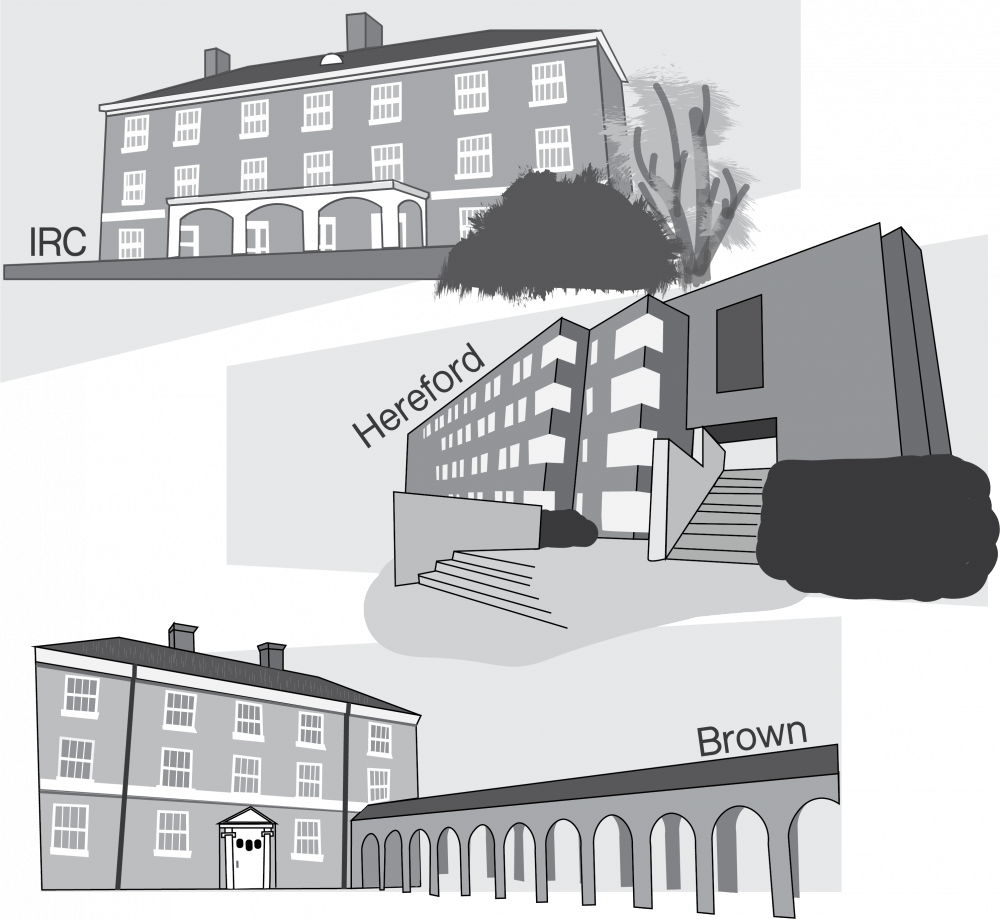Thomas Jefferson’s ideal for the academical village is to extend learning beyond the classroom and into the home, particularly illustrated in a unique housing option for students — residential colleges, which are meant to be combined spaces for living and learning for both peers and faculty members. The University has three residential colleges — Hereford, Brown and the International Residential College — each with their own theme and central focus.
Hereford Residential College is made up of two hall-style dorm buildings, Norris and Whyburn. First-year residents typically live in double-occupancy rooms, while upperclassmen live in single-occupancy rooms. Hereford is located at the top of Observatory Hill, and its theme is encouraging sustainability, mindfulness and cultural diversity. Second-year College student Chyna Brown lived in Hereford her first year and explained the many ways in which she saw Hereford students and faculty living out these ideals.
“Sustainability was a big thing,” Brown said. “So you were supposed to bring your own cups, plates and silverware to the events because they didn’t want you to throw away plastic.”
Avoiding single-use plasticware is just one of Hereford students’ attempts to live sustainably. According to its website, residents also organize low or no-waste events and regularly practice composting. In addition to its sustainability efforts, Brown also mentioned that Hereford hosts several mindfulness retreats each year — these can involve learning about meditation, a trip to a nearby farm or some other event that allows students to recharge from the hectic school year.
Brown also spoke very highly of the community that Hereford provided her first year. She described several events that Hereford students can attend, such as a cookie night every Thursday night in the Hub — a shared space in one of the Hereford houses — viewing parties for the University’s sporting events and the Hereford Cup — a football game played between the two houses. Brown also noted that she found community simply by meeting others on her hall.
“Even if you don’t go to the events, it is very easy to bond with your hall,” Brown said. “There are hall dinners and all sorts of things like that, so I’m still in contact with a lot of people on my hall… They are some of my best friends.”
The cost of living in Hereford for a single is $6,820 per academic year, while a double costs $6,480 per academic year. Students seeking to become one of the 200 living in Hereford must fill out an application on the Housing and Residence Life website with questions about why they want to live in a community with Hereford’s ideals.
The next and the oldest of the three residential halls is Brown College. Brown is located the most centrally out of the residential colleges on Monroe Hill and consists of 12 interconnected buildings, housing about 280 students. Most residents in Brown live in suites made up of a single room connected to another single. First-year suites typically include one single connected to a double. Each suite is connected to at least one other suite via a common bathroom. Regardless of the room set-up, the cost of living in Brown for each academic year is $7,500.
Residents of Brown — also known as “Brownies” — have been described as “the interested and the interesting,” according to the residential college’s website and third-year College student Austin Rhea. Rhea has lived in Brown for all three of her years at the University. She admires the tight-knit community that Brown can provide within the sea of students at the University. Rhea also noted that the residential college makes funds available to all residents, which allows them to express their interests and put on their own events.
Like the other residential colleges, living in Brown is meant to provide a space for residents to express themselves and grow closer together. Incoming Brownies are assigned only one mandatory task — they must all enroll in a Brown-specific class for their first semester as a resident. According to Rhea, its purpose is centered around meeting fellow Brownies and hearing from guest speakers.
Among the many annual events at Brown College is the popular Hauntings on the Hill, a fall event which Rhea helped to coordinate last year. Hauntings on the Hill is a haunted house in Brown that University students and community members can visit. All proceeds from ticket sales go to local Charlottesville charities such as The Haven, which aids the homeless, and the Sexual Assault Resource Agency, a non-profit that advocates against sexual assault.
Brown hosts many other charitable events such as the Brown Art & Music — also referred to as BAM — a spring festival in which student groups from the University can put their art, music and other talents on display alongside Brown residents themselves.
“I think Brown is kind of unknown, and there might be some misconceptions about it,” Rhea said. “But I would highly recommend just taking a tour or talking to a Brownie about their experience living here because it really has been a formative part of my time at U.Va.”
The Brown College application is linked on the Housing and Residence Life website. It includes a couple of questions written by current and former Brown residents about the prospective resident’s interests and personality traits. These questions, according to Brown’s website, are a little outside the realm of stereotypical application questions, and they are advertised as even being enjoyable to complete.
The third and final residential college is the International Residential College, a hall-style building on Emmett Street across from Memorial Gymnasium. According to the HRL website, the 300-plus IRC residents are comprised of 60 percent domestic and 40 percent international students. These residents are spread throughout four dorm buildings — Mary Munford, Yen, Roberta Gwathmey and Hoxton House. Between these four houses, residents can choose to live in singles, doubles or suite-style rooms. The cost of living in a single in the IRC is $7,500 per academic year, while the cost of living in a double is $6,480 per academic year.
Second-year College student Richella Tah moved into the IRC this year after living in first-year dorms last year, and described how the IRC provides her with ample opportunity to meet many new people with backgrounds different from her own.
“I chose to live in the IRC because I wanted a different community than I had my first year living in regular dorms,” Tah said. “I wanted one that I could meet a variety of different people — exchange students and just other people I probably wouldn’t have any exposure to [otherwise].”
Like the other residential colleges, the IRC hosts many events in order to help their residents get to know each other, though none of these are mandatory. Tah noted that her favorite part of living there so far has been the breakfast events hosted three days a week — Monday Muffins, Petite Dejeuner and Friday Bagels. She also mentioned that her building, Munford, has a table on the first floor called “The Potlatch” where residents often leave snacks and other goodies for anyone to enjoy.
“Every week we are getting emails about dinners with professors and stuff like that,” Tah said. “And there are different trips you can go to — I know in a couple weeks they are going to the [National Museum of African American History and Culture] in Washington, D.C.”
Beyond the dinners and trips, Tah mentioned events such as “The Week That Was” meeting, in which both residents and faculty meet to discuss current events and mingle with their peers. IRC residents also have access to exclusive study abroad programs, namely the IRC in London and Oxford program.
Students seeking to live in the IRC complete an application on the HRL website with questions about why they want to live in a multicultural community, as well as about their general interests.
Although the three residential colleges have different themes, they are all designed for students who want to bring learning into the home and grow alongside their peers, whether that be in pursuit of environmental, cultural or creative knowledge. Students looking to apply to these residential colleges can find their respective applications on the HRL website, though acceptance rates will vary based on the number of rooms available. Rhea shared some encouraging advice for students checking out residential colleges.
“Embrace it,” Rhad said. “Don’t be one of those people who only lives in a [residential] college to get out of first-year dorms and never participates. They have so much to offer, and you should definitely embrace the opportunities that come up no matter which you pick.”







